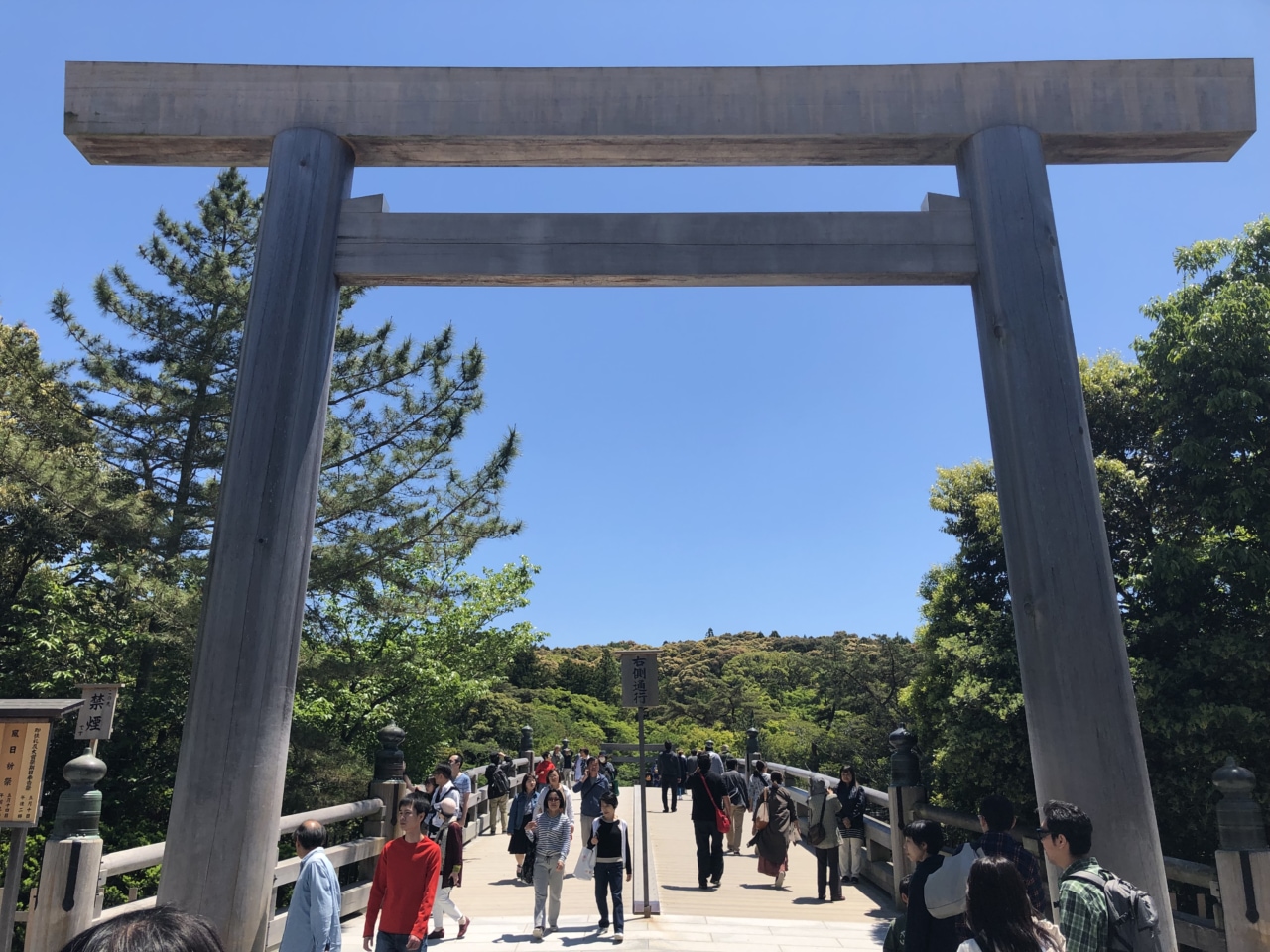
Image: Ise Jingū, Photo by the author
Japan is home to over 80,000 Shinto shrines—far surpassing the approximately 54,000 convenience stores nationwide as of 2024.
When including auxiliary shrines, roadside altars, and unregistered local shrines, the total number is estimated to reach between 200,000 and 300,000.
This remarkable figure illustrates just how deeply shrines are embedded in Japanese culture.
Although there is no standardized government system for shrine classification, their immense variety allows categorization from several perspectives.
Below, we introduce the major ways shrines are classified.
- Classification by Deity
- Classification by Name or Status
- Classification by Architectural Style
- 1. Hachiman Shrines
- 2. Inari Shrines
- 3. Tenmangū Shrines
- 4. Ise Jingū
- 5. Izumo Taisha
- 6. Kumano Shrines
- 7. Kasuga Shrines
- 8. Suwa Shrines
- 9. Itsukushima Shrine
- 10. Sumiyoshi Shrines
- 11. Konpira Shrines
- 12. Ebisu Shrines
- Final Thoughts
Classification by Deity
Shrines are often categorized based on the deity (kami) they enshrine.
This is the most widespread classification method.
Examples include Inari shrines, Hachiman shrines, and Tenmangū shrines.
Among major types alone, there are over 20 varieties recognized across Japan.
Classification by Name or Status
Another method involves classifying shrines by their names or their historical and institutional roles:
Jingū: Shrines closely connected to the imperial family or the nation (e.g., Ise Jingū, Meiji Jingū)
Taisha: Prominent shrines of national or regional significance (e.g., Izumo Taisha)
Jinja: A general term for shrines, the most common throughout Japan
Gū: Shrines enshrining imperial or historical figures (e.g., Kashii-gū)
Sessha and Massha: Smaller shrines associated with a main shrine’s deity or tradition
Hokora: Tiny shrines found along roadsides or in the mountains
Even just by name and status, shrines can be divided into around 10 to 15 categories.
Classification by Architectural Style
Shrines can also be classified by their architectural styles, with key examples including:
Shinmei-zukuri: A simple, ancient style exemplified by Ise Jingū
Taisha-zukuri: A grand, archaic style seen at Izumo Taisha
Kasuga-zukuri: A compact, elegant style typical of Kasuga Taisha
Nagare-zukuri: The most common style nationwide, featuring a roof that slopes forward
These major architectural styles alone account for four to five main types.
In this article, we will focus on shrines categorized by their deities and introduce twelve representative lineages.
1. Hachiman Shrines
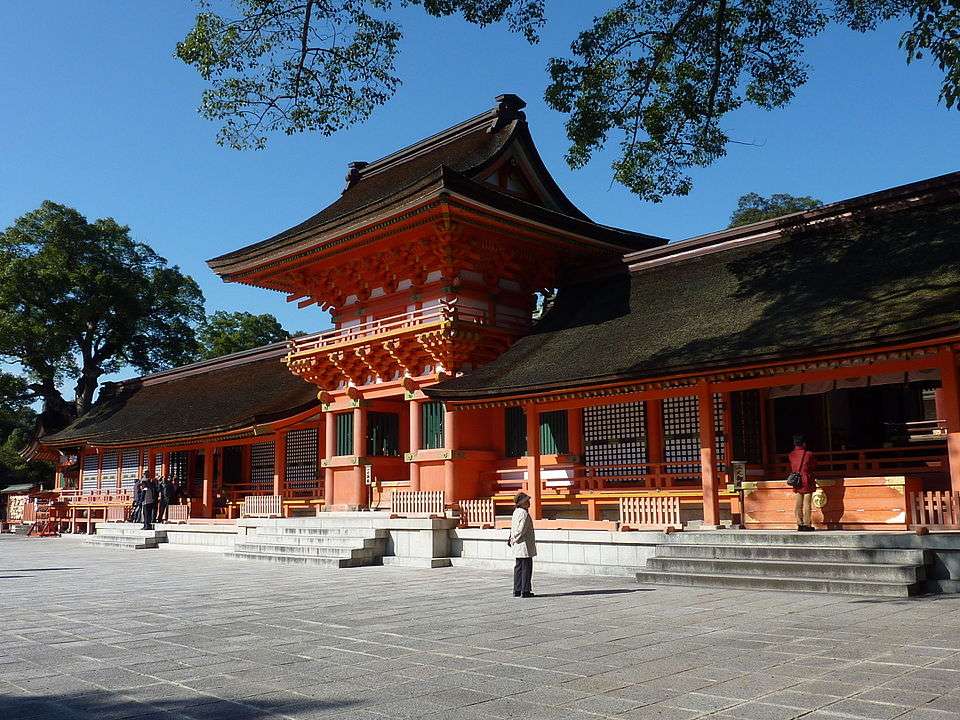
Image: South Central Tower Gate of Usa Jingū, Photo by Sanjo (via Wikimedia Commons)
Hachiman shrines form the largest lineage among Japanese shrines, with approximately 44,000 locations across the country.
The main deity worshiped is Hachiman (also known as Yahata-no-Kami), generally identified with Emperor Ōjin, Japan’s 15th emperor.
Emperor Ōjin has long been revered as a god of war and protector of the nation, widely worshiped for military victories and national defense.
In many shrines, he is enshrined together with his mother, Empress Jingū, and a group of goddesses collectively called Himegami.
The head shrine is Usa Jingū in Usa City, Ōita Prefecture, serving as the center of Hachiman worship nationwide.
Other prominent examples include Iwashimizu Hachimangū in Kyoto and Tsurugaoka Hachimangū in Kamakura, both of which gained strong devotion from the warrior class during the medieval period.
Hachiman is particularly venerated as the guardian deity of archery and martial arts, revered by many military clans such as the Minamoto and Taira families.
2. Inari Shrines
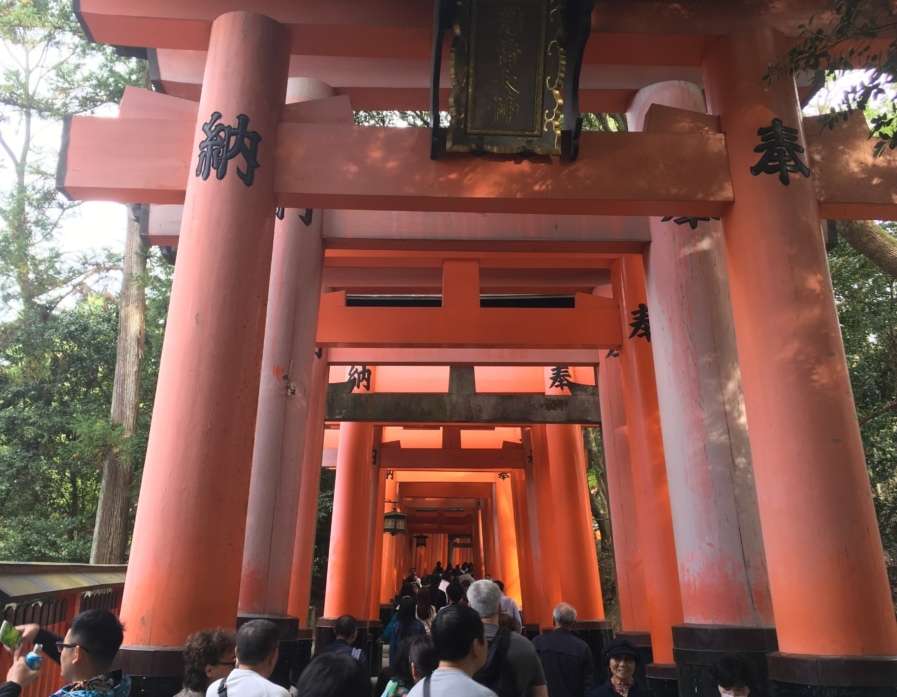
Image: Fushimi Inari Taisha, Photo by the author
Inari shrines are dedicated to Ukanomitama-no-Kami, the deity of prosperity and abundant harvests.
There are approximately 30,000 Inari shrines across Japan.
A distinctive feature of Inari worship is the veneration of foxes as sacred messengers (kenzoku) of the deity.
The head shrine is Fushimi Inari Taisha in Kyoto, renowned for its thousands of vermilion torii gates forming striking tunnels—a landscape that has become an iconic image of Japanese spirituality and a major tourist attraction.
Originally worshiped as a god of agriculture, Inari’s role expanded during the Edo period to include commerce and business success.
Today, Inari shrines attract a wide range of worshippers, from farmers and merchants to corporate leaders and investors.
The vivid image of red torii gates lined up in succession has become the universal symbol of Inari shrines across Japan.
3. Tenmangū Shrines
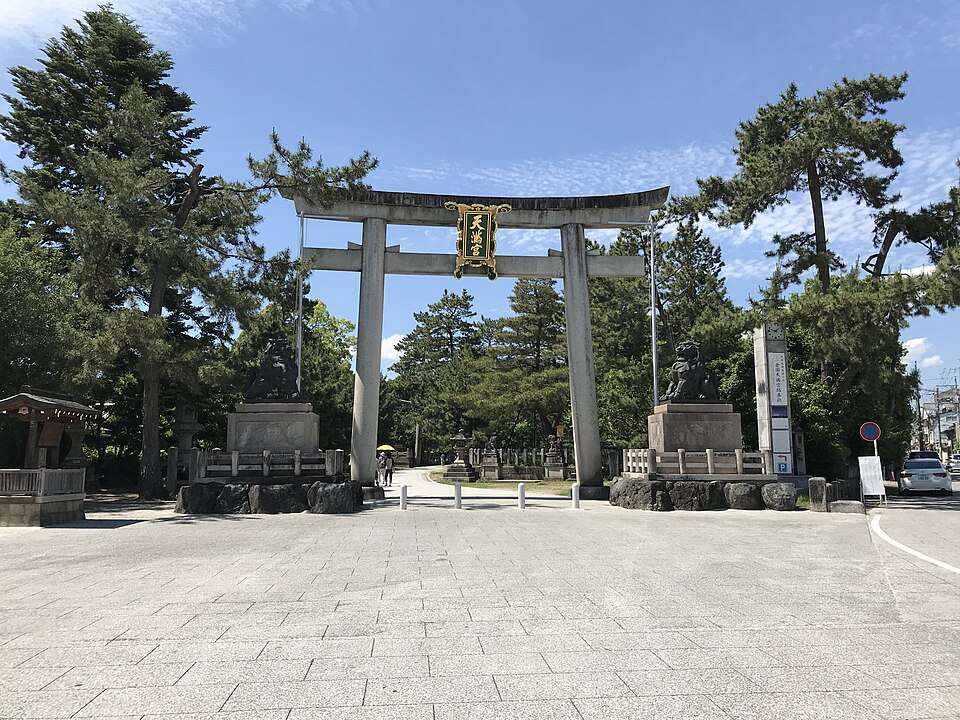
Image: First Torii Gate of Kitano Tenmangū, Photo by Tokyo-Good (via Wikimedia Commons)
Tenmangū shrines are dedicated to Sugawara no Michizane, revered as the deity of learning and scholarship.
There are about 12,000 Tenmangū shrines across Japan, making them second only to Inari shrines in number.
Sugawara no Michizane was a renowned scholar and statesman during the Heian period, but he fell from political favor and was exiled to Dazaifu, where he died in sorrow.
After his death, a series of disasters struck the imperial court and Kyoto, leading people to fear that Michizane’s spirit had become a vengeful ghost.
In response, shrines were built to enshrine him as Tenjin (Heavenly Deity) to appease his spirit, giving rise to the widespread Tenjin faith.
The most famous Tenmangū shrines are Kitano Tenmangū in Kyoto and Dazaifu Tenmangū in Fukuoka Prefecture, both regarded as the principal centers of Tenjin worship.
The plum blossom, beloved by Michizane, has become a symbol of Tenjin shrines.
Today, plum trees fill their precincts, attracting many visitors during the plum blossom season each year.
4. Ise Jingū
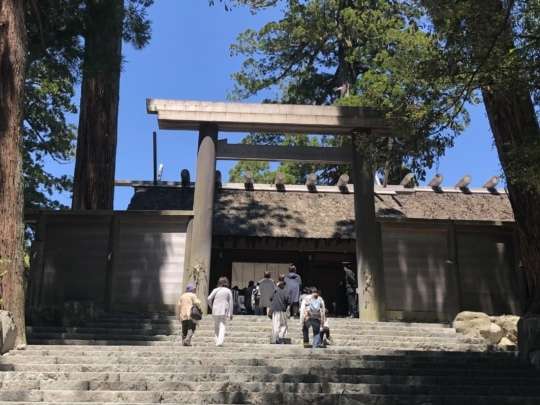
Image: Ise Jingū (Inner Shrine), Photo by the author
Ise Jingū occupies a central position in Shinto and consists primarily of the Inner Shrine (Naikū) and the Outer Shrine (Gekū), along with 123 auxiliary, subsidiary, and associated shrines spread throughout the city of Ise.
The Inner Shrine enshrines Amaterasu Ōmikami, the sun goddess and the ancestral deity of the imperial family.
The Outer Shrine enshrines Toyouke Ōmikami, the goddess of food, agriculture, and industry.
Located in Ise City, Mie Prefecture, Ise Jingū is often referred to as the “head shrine” of Shinto.
Since ancient times, it has played a vital role in state rituals and religious practices across Japan.
One of Ise Jingū’s most important traditions is the Shikinen Sengū, a ritual rebuilding of the shrine complex every 20 years.
This practice, which has continued for over 1,300 years, is not merely an architectural renewal but a profound cultural and spiritual event symbolizing continuity and the transmission of traditional craftsmanship.
Even today, Ise Jingū retains a unique, sacred status as a national center of Shinto worship.
5. Izumo Taisha
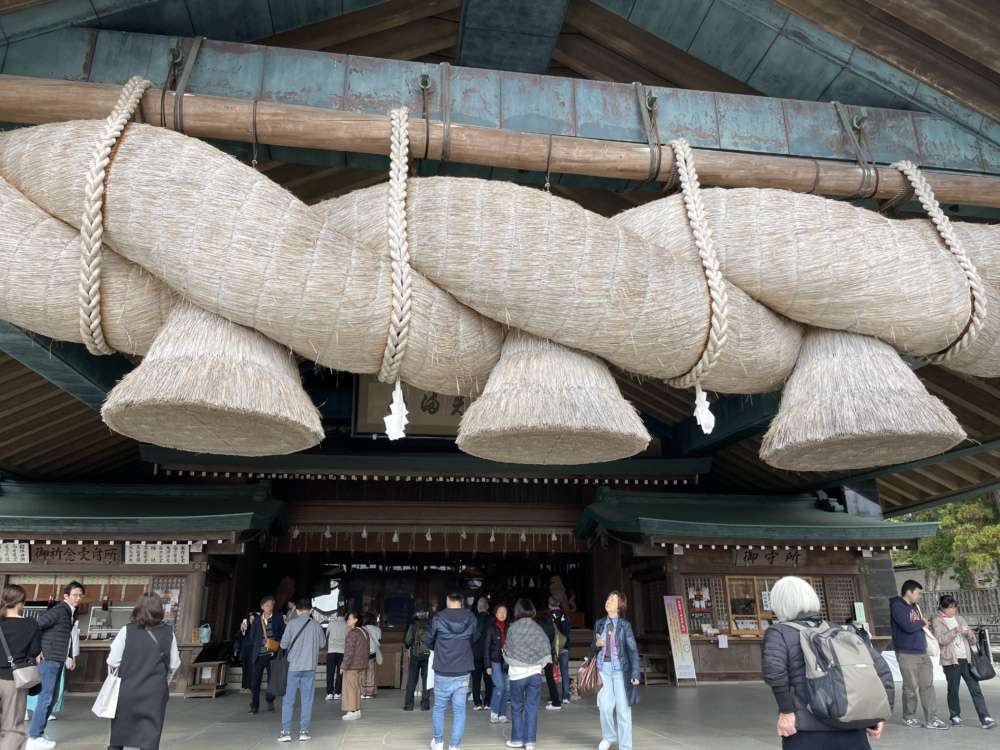
Image: Kaguraden and Great Sacred Rope at Izumo Taisha, Photo by the author
Izumo Taisha, located in Izumo City, Shimane Prefecture, enshrines Ōkuninushi no Ōkami, a major deity known for creating the land of Japan and fostering connections among people.
Ōkuninushi is widely revered as the god of nation-building, relationships, and matchmaking.
While there are around 200 branch shrines across the country, the head shrine is Izumo Taisha itself.
In the old lunar calendar, the 10th month is traditionally called Kannazuki, meaning “the month without gods,” but in Izumo it is known as Kamiarizuki, “the month when the gods are present,” because it is believed that all the deities from across Japan gather at Izumo during this time.
The massive sacred rope (shimenawa) hung at the Kaguraden (Sacred Dance Hall) is a powerful symbol of Izumo Taisha, attracting countless visitors.
Although there are fewer Izumo-affiliated shrines compared to other major lineages, Izumo Taisha occupies an exceptionally high place in Japanese mythology, particularly as described in ancient texts like the Kojiki and Nihon Shoki.
6. Kumano Shrines
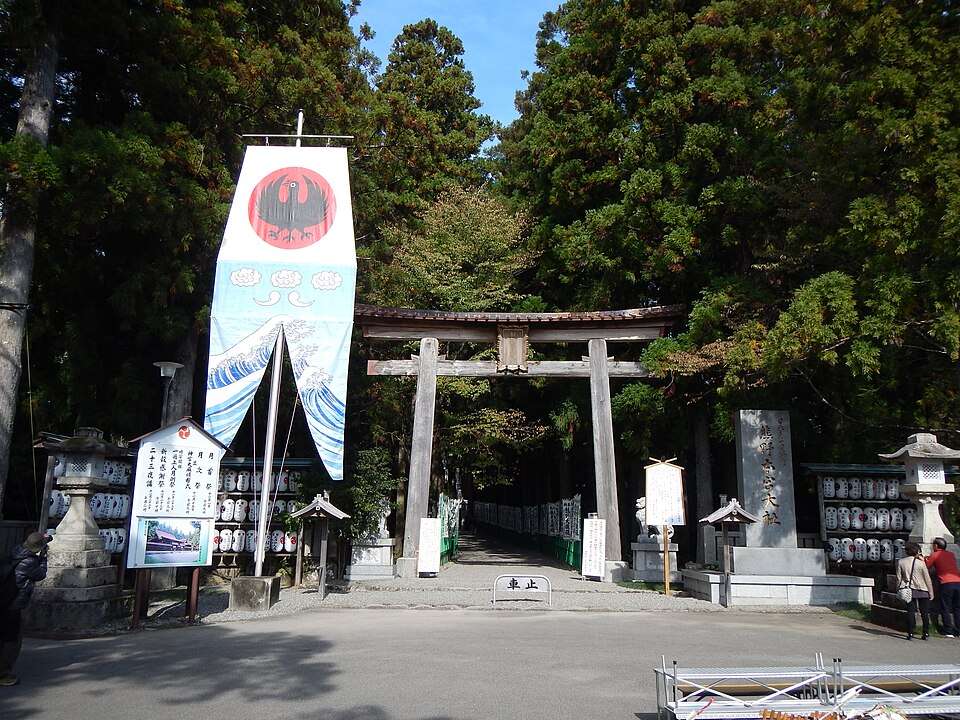
Image: Torii Gate of Kumano Hongū Taisha, Photo by Nekosuki (via Wikimedia Commons)
Kumano shrines are centered around the Kumano Sanzan—the three grand shrines of Kumano Hongū Taisha, Kumano Hayatama Taisha, and Kumano Nachi Taisha—in Wakayama Prefecture.
Approximately 3,000 Kumano-affiliated shrines exist across Japan.
These shrines enshrine multiple deities, including Ketsumimiko no Ōkami, Kumano Hayatama no Ōkami, and Kumano Fusumi no Ōkami, and their worship has been heavily influenced by ancient nature worship and Shugendō (mountain ascetic practices).
The Kumano Sanzan themselves serve as the spiritual centers of Kumano faith.
From the medieval period onward, the region became a major pilgrimage destination, attracting emperors, aristocrats, warriors, and commoners alike, who sought purification and spiritual rebirth.
The Kumano Kodo pilgrimage routes, which connected various sacred sites, are now recognized as a UNESCO World Heritage site, and they reflect the historical spread and depth of Kumano worship.
7. Kasuga Shrines
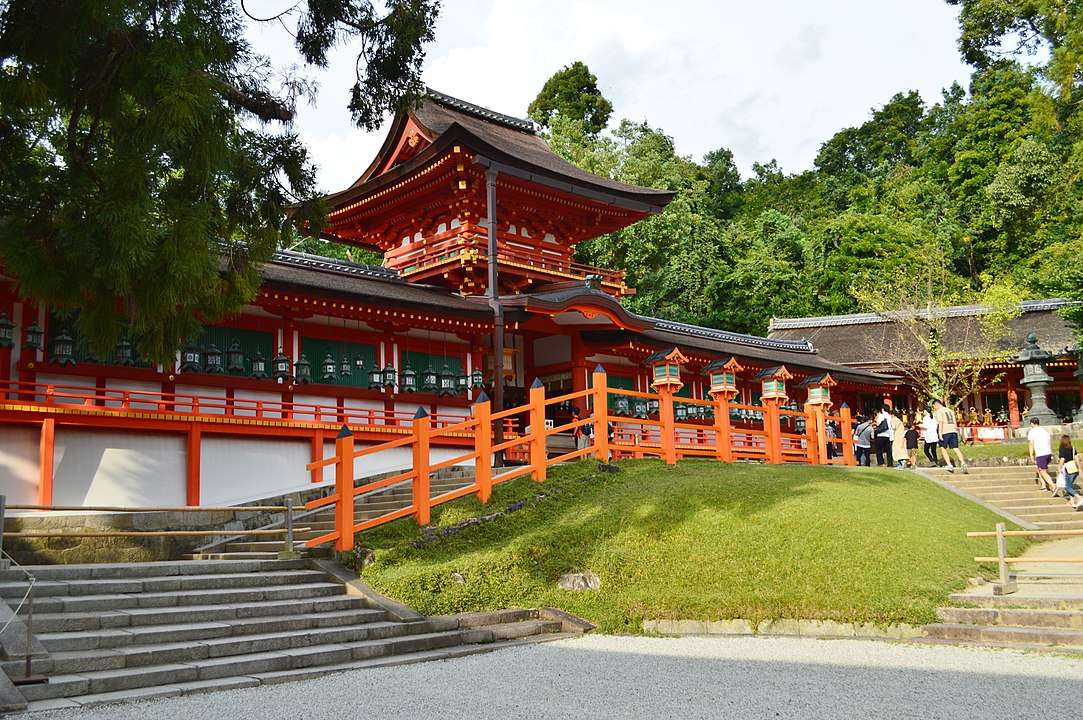
Image: Chūmon Gate of Kasuga Taisha, Photo by Saigen Jiro (via Wikimedia Commons)
Kasuga shrines are centered around Kasuga Taisha in Nara Prefecture, with approximately 1,000 affiliated shrines throughout Japan.
The main deities enshrined are Takemikazuchi no Mikoto, Futsunushi no Mikoto, Amenokoyane no Mikoto, and Himegami—all closely associated with the powerful Fujiwara clan.
These deities are revered as guardians of martial prowess, national protection, and prosperity.
During the Heian period, as the Fujiwara clan’s influence expanded, Kasuga worship also spread throughout the country.
A distinctive feature of Kasuga Taisha is the sacred deer that roam freely within its grounds, considered messengers of the gods.
Kasuga Taisha is famous for its elegant shrine architecture and the thousands of stone and bronze lanterns donated by worshippers, which illuminate the precincts during festivals.
Architecturally, it holds an important place in the history of Shinto shrine construction in Japan.
8. Suwa Shrines
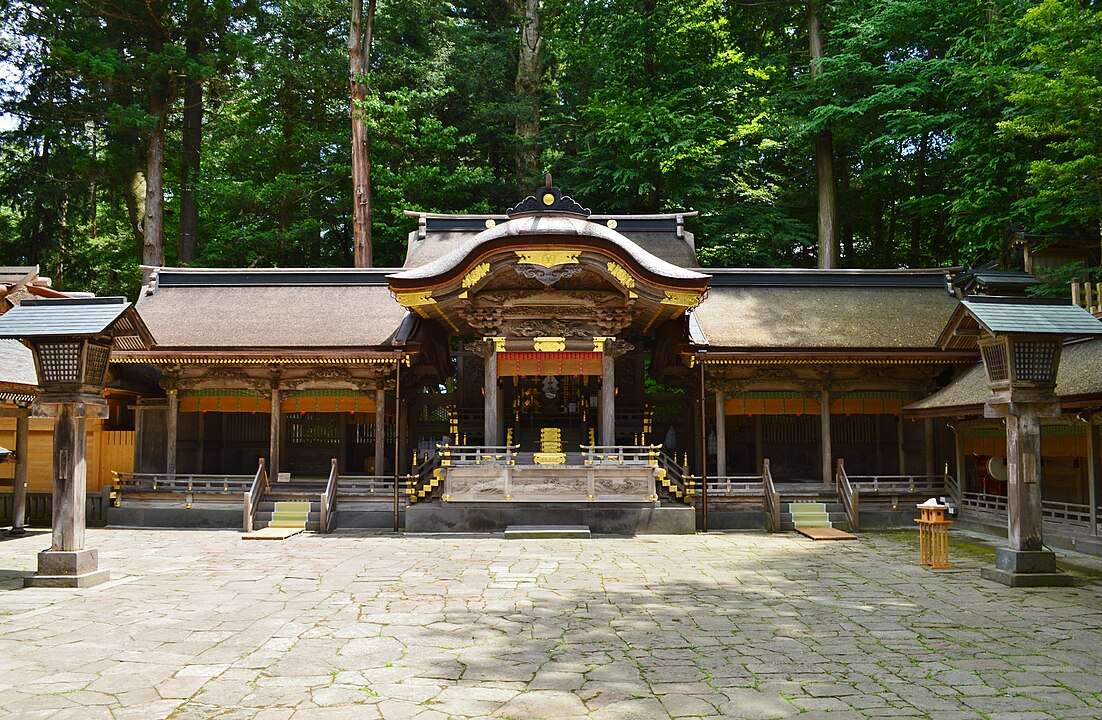
Image: Worship Hall of Suwa Taisha Upper Shrine, Photo by Saigen Jiro (via Wikimedia Commons)
Suwa shrines are centered around Suwa Taisha in Nagano Prefecture, with approximately 5,000 affiliated shrines across Japan.
The main deity enshrined is Takeminakata no Kami, a god associated with wind, water, hunting, and military strength.
Suwa worship has historically attracted warriors, hunters, and mountain communities, who revered Takeminakata for protection and success in their pursuits.
Suwa Taisha has a unique structure, consisting of four main shrines: the Upper Shrine (comprising Maemiya and Honmiya) and the Lower Shrine (comprising Harumiya and Akimiya).
The shrine is renowned for the Onbashira Festival, held every seven years, during which massive logs are cut from the mountains and transported to the shrine in a dramatic, sacred ritual.
Suwa shrines are deeply rooted in ancient nature worship, with practices emphasizing the veneration of sacred mountains rather than reliance on built structures.
Regional variations in worship style and folklore are also a hallmark of Suwa-affiliated shrines.
9. Itsukushima Shrine
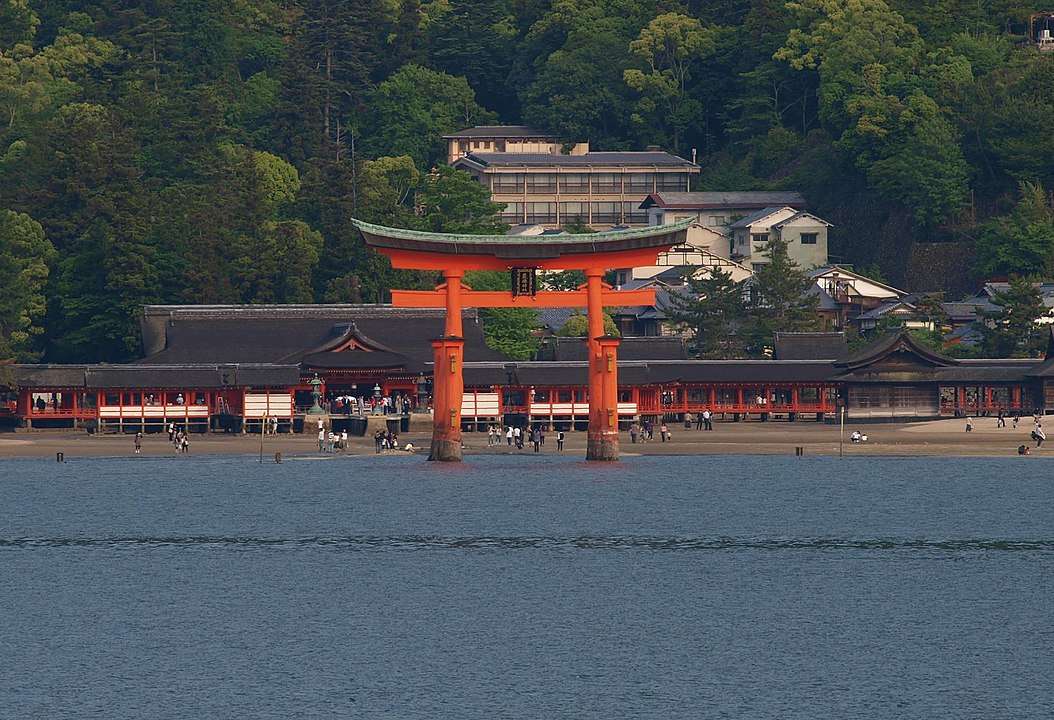
Image: Great Torii and Shrine Buildings of Itsukushima Shrine, Photo by Merec0 (via Wikimedia Commons)
Itsukushima Shrine is located on Miyajima Island in Hatsukaichi City, Hiroshima Prefecture, and is the head shrine for approximately 500 affiliated shrines across Japan.
The primary deity enshrined is Ichikishimahime no Mikoto, one of the three Munakata goddesses, who are known as protectors of the seas.
Ichikishimahime later became associated with Benzaiten, the goddess of water, music, and prosperity, blending Shinto and Buddhist traditions.
The hallmark of Itsukushima Shrine is its dramatic structure, appearing to float on the sea during high tide.
The enormous vermilion torii gate and the shrine buildings themselves form one of Japan’s most iconic sacred landscapes.
Itsukushima Shrine is recognized as a UNESCO World Heritage Site and serves as a powerful symbol of the unity between nature and spirituality.
Since ancient times, it has been worshiped as a guardian of maritime safety and transportation, and today it remains deeply revered by those involved in travel, shipping, and commerce.
10. Sumiyoshi Shrines
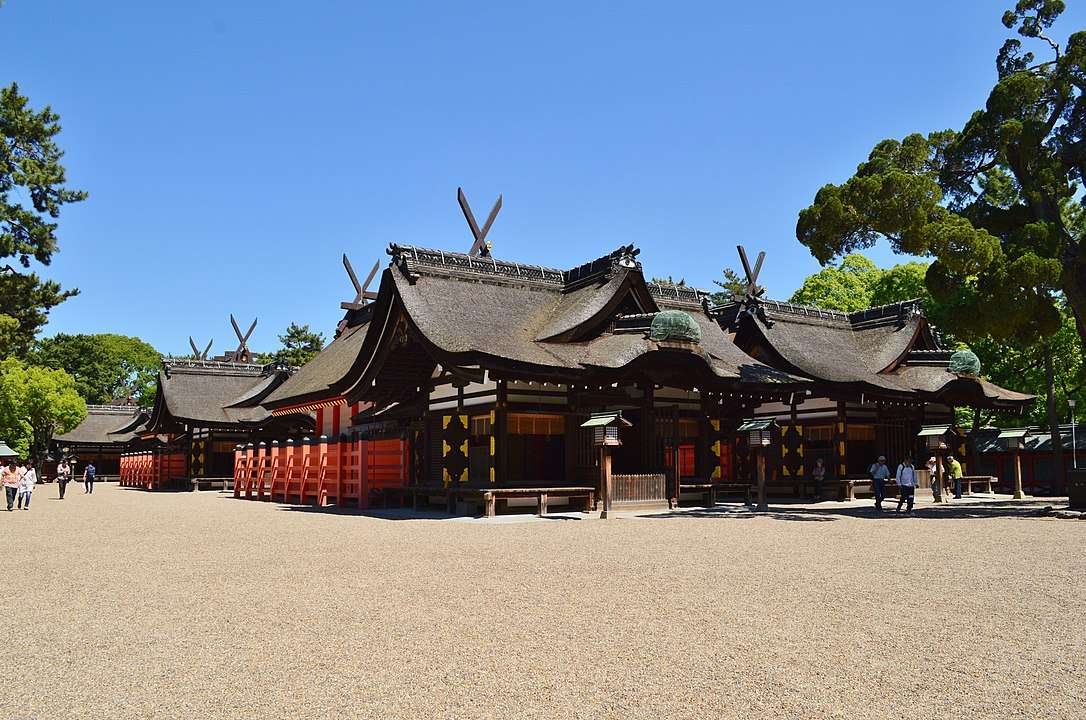
Image: Sumiyoshi Taisha Main Shrine, Photo by the author
Sumiyoshi shrines are centered around Sumiyoshi Taisha in Osaka City and number approximately 2,300 across Japan.
The main deities enshrined are the three Sumiyoshi gods—Sokotsutsuno no Mikoto, Nakatsutsuno no Mikoto, and Uwatsutsuno no Mikoto—along with Empress Jingū at many locations.
The Sumiyoshi gods are ancient deities associated with safe sea voyages, and they were particularly revered by seafaring communities and fishermen.
Sumiyoshi Taisha holds a particularly prestigious status, being considered one of Japan’s Four Great Shrines alongside Ise Jingū, Kashima Jingū, and Katori Jingū.
It is also notable for its unique architectural style called Sumiyoshi-zukuri, characterized by straight, simple lines and a distinctive roof design, making it a rare surviving example of an ancient shrine architectural form.
Sumiyoshi shrines were not only revered for maritime safety but also became associated with waka poetry and cultural arts over time, broadening their spiritual significance.
11. Konpira Shrines
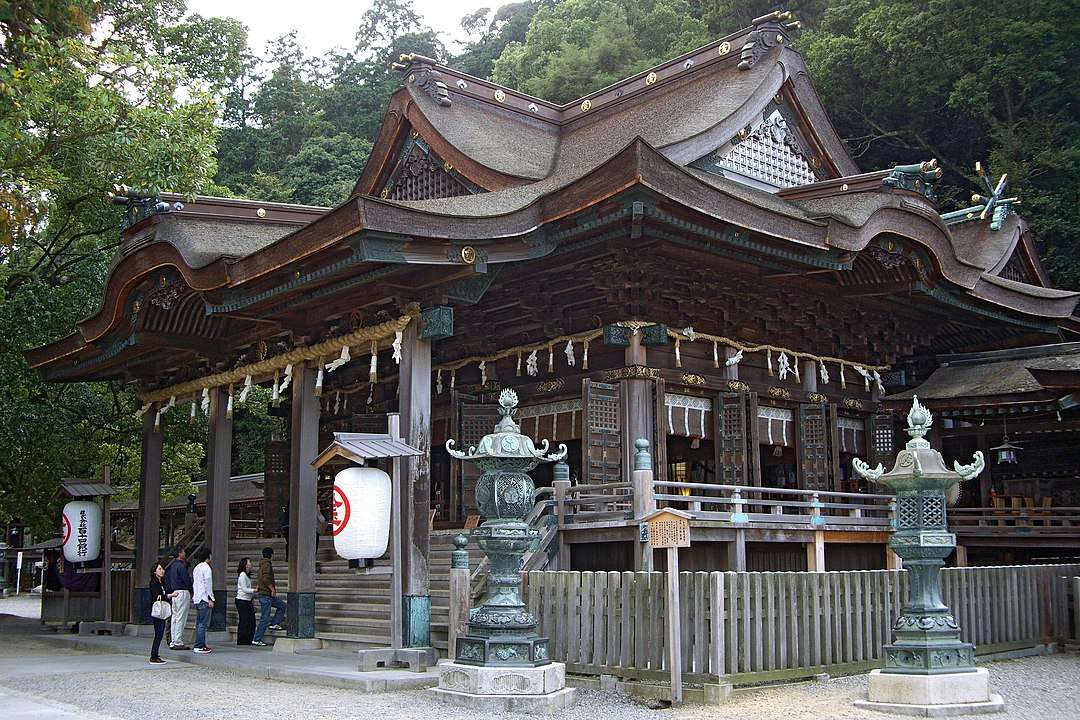
Image: Main Worship Hall of Kotohira-gū, Photo by Toto-tarou (via Wikimedia Commons)
Konpira shrines are centered around Kotohira-gū in Kotohira Town, Kagawa Prefecture, and approximately 600 affiliated shrines exist across Japan.
Kotohira-gū, affectionately known as “Konpira-san,” has long been a place of worship for maritime safety, commercial prosperity, and bountiful harvests.
The main deity enshrined is Ōmononushi no Kami, a Shinto god associated with the sea and agriculture.
Originally, Konpira worship blended Shinto and Buddhist elements during the syncretic period of Japanese religious history.
Following the Meiji Restoration and the separation of Shinto and Buddhism (Shinbutsu Bunri), Kotohira-gū became a purely Shinto institution.
Many branch shrines carry variations of the name, such as “Kotohira Shrine,” “Konpira Shrine,” or “Kompira Shrine,” depending on the region.
Konpira shrines are especially common in port towns, fishing villages, and commercial centers, where they continue to be revered as guardians of safe travel and prosperous business.
12. Ebisu Shrines
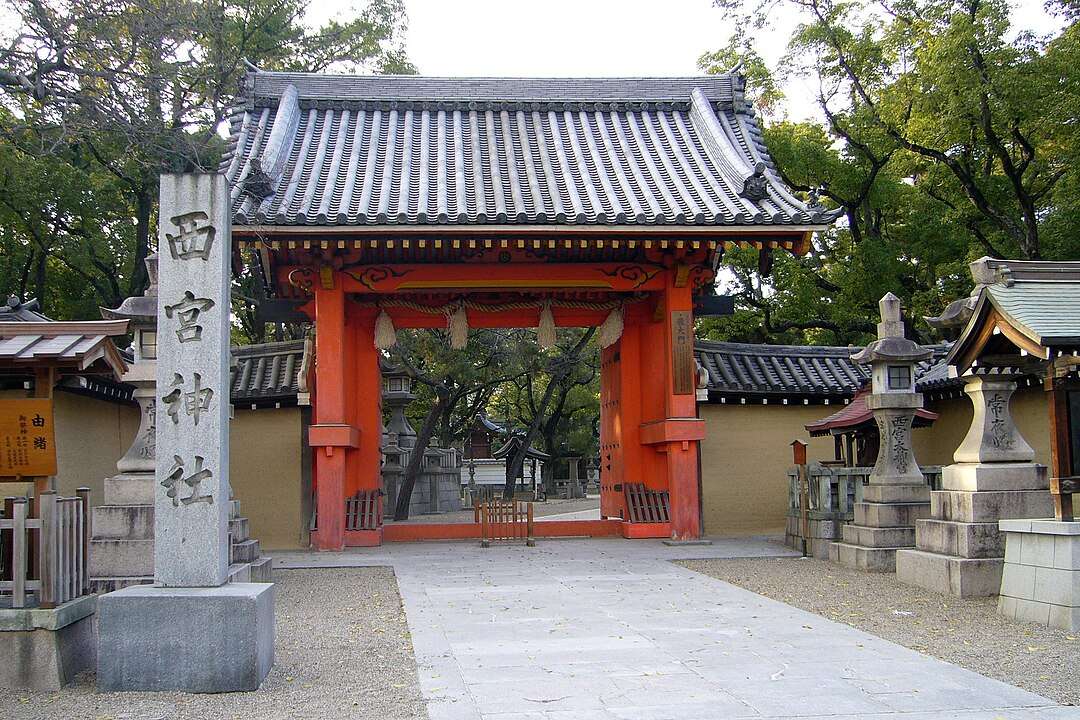
Image: Main Gate of Nishinomiya Shrine, Photo by 663highland (via Wikimedia Commons)
Ebisu shrines are centered around Nishinomiya Shrine in Hyōgo Prefecture, regarded as the head shrine of Ebisu worship across Japan.
Ebisu is widely revered as the god of prosperity in business and the guardian of fishermen and commerce.
Approximately 3,500 Ebisu shrines exist nationwide, although their names vary by region—such as “Ebisu Shrine,” “Ebisu-jinja,” or “Ebisu-sama Shrine.”
One of the most famous events is the “Lucky Man Race” (Fukuotoko Erabi) held every January 10 at Nishinomiya Shrine, where participants race to become the year’s first “lucky man.”
Besides Nishinomiya Shrine, other prominent centers of Ebisu worship include Imamiya Ebisu Shrine in Osaka and Ebisu Shrine in Kyoto, collectively known as the “Three Great Ebisu Shrines.”
Ebisu continues to be deeply venerated today by merchants, businesspeople, and those seeking success and prosperity in their ventures.
Final Thoughts
There are approximately 88,000 officially registered shrines in Japan today.
When including auxiliary shrines, subsidiary shrines, and small roadside altars, the actual number is likely even higher.
Among the many types of shrines, Hachiman Shrines (approximately 44,000), Inari Shrines (approximately 30,000), and Tenmangū Shrines (approximately 12,000) stand out for their overwhelming numbers.
Each type of shrine embodies a distinct role—whether protecting warriors, promoting academic success, or ensuring agricultural prosperity—and has played a vital part in the life of local communities throughout Japan’s history.
Underlying these traditions is a deep-rooted faith shaped by Japan’s unique climate, culture, and historical development.
Even today, shrines are not merely places of worship.
They continue to serve as centers for prayer, tourism, and local community life, preserving the living spirit of Japanese culture.
References : Official Website of Jinja Honchō (The Association of Shinto Shrines),Other historical sources


